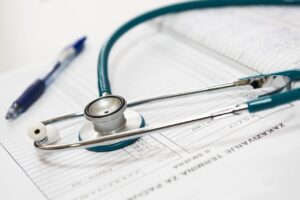When I first started becoming sexually active, I often wondered, “How do I know if I have an STD?”
The thought of sexually transmitted diseases (STDs) can be daunting.
It’s crucial to understand what STDs are and how they can impact our health.
In this article, I want to share my insights on recognizing the signs, knowing the symptoms, and understanding the importance of getting tested for STDs.

What Are STDs?
STDs, or sexually transmitted diseases, are infections that are primarily spread through sexual contact.
They can be caused by bacteria, viruses, or parasites.
While there are many types of STDs, some of the most common ones include chlamydia, gonorrhea, human immunodeficiency virus (HIV), herpes, and syphilis.
Being educated about STDs is essential for my sexual health and well-being.
Common Symptoms of STDs
One of the first questions I had was about the symptoms of STDs.
Knowing the symptoms is key to understanding how do I know if I have an STD?
However, it’s important to remember that not everyone shows symptoms.
Here are some common symptoms I learned to watch out for:
General Symptoms
- Unusual Discharge: I noticed that any unusual discharge from the vagina or penis could indicate an issue.
- Pain During Urination: If I ever felt pain or burning while urinating, that was a red flag.
- Sores, Bumps, or Blisters: Any sores or bumps around the genital area could signal an STD.
- Itching or Irritation: Persistent itching or irritation in the genital area should not be ignored.
Symptoms in Men
In men, there are specific symptoms to consider when wondering, “How do I know if I have an STD?”
- Testicular Pain: If I ever experienced pain or swelling in the testicles, it was time to seek medical attention.
- Penile Discharge: Any unusual discharge from the penis is a common symptom that shouldn’t be overlooked.
Symptoms in Women
For women, I learned that the symptoms could also vary.
- Unusual Vaginal Discharge: A change in vaginal discharge—whether it’s color, odor, or consistency—can indicate an STD.
- Pelvic Pain: Persistent pain in the lower abdomen or pelvic area might signal a serious infection.
What If There Are No Symptoms?
This was a tough realization for me.
Many STDs can be asymptomatic, meaning they don’t show any symptoms.
So, even if I felt perfectly fine, I could still have an STD.
This is why regular testing is so vital, especially if I’m sexually active.
I made it a priority to get tested regularly, even when I didn’t notice any unusual symptoms.
How to Get Tested for STDs
Now, you might be wondering, “How do I know if I have an STD?”
The best answer is to get tested.
Here’s how I navigated the testing process:
Where to Get Tested
There are several options for STD testing.
I found that local health clinics, Planned Parenthood, and even some online STD testing services offered great solutions.
Researching reputable clinics in my area made the process much less intimidating.
Types of Tests
When it comes to testing, there are a few different types I learned about:
- Urine Tests: These tests check for bacterial STDs like chlamydia and gonorrhea.
- Blood Tests: Blood tests are necessary for detecting viruses like HIV and herpes.
- Swabs: In some cases, a healthcare provider may take a swab from any sores or unusual discharge.
When to Get Tested
Timing is essential.
I learned that I should consider getting tested in the following situations:
- After unprotected sex
- If I had multiple sexual partners
- If I developed new symptoms
The sooner I could get tested, the better my chances of getting treatment.
What to Do If You Test Positive for an STD
If I were to test positive for an STD, I knew it would be a challenging situation.
Here’s what I would do:
Seeking Medical Treatment
The first step would be to seek medical treatment.
Most STDs are treatable, especially when caught early.
For bacterial infections, antibiotics can usually clear things up quickly.
For viral infections like HIV or herpes, there are medications available to manage the condition.
Talking to Your Partner
Having a positive diagnosis can be tough, especially when it comes to communication.
I learned that it’s important to talk openly and honestly with any sexual partners.
Here are some tips that helped me prepare for that conversation:
- Choose the Right Time: I would wait for a calm moment when we could talk without distractions.
- Be Honest and Direct: I would explain the situation clearly, focusing on the importance of both of our health.
- Provide Resources: I’d share resources so they can understand the situation better and know what steps to take next.
Preventing Future Infections
After a diagnosis, preventing future infections is crucial.
I knew I needed to adopt safer sex practices:
- Use condoms or dental dams during sexual activity.
- Limit the number of sexual partners.
- Get vaccinated for preventable STDs like HPV and hepatitis B.
- Schedule regular check-ups to stay informed about my sexual health.
How to Prevent STDs
Prevention is always better than cure.
I made it a point to prioritize my sexual health in several ways:
- Use Protection: Always using condoms or dental dams helped reduce the risk of STDs.
- Limit Partners: By limiting the number of sexual partners, I minimized my exposure to potential infections.
- Get Vaccinated: Vaccines for HPV and hepatitis B are effective tools in preventing certain STDs.
- Regular Testing: I made a habit of getting tested regularly, even when I felt fine.
Frequently Asked Questions (FAQs)
Now, let’s address some common questions I had about STDs:
Q1: How soon can I get tested after possible exposure to an STD?
Testing timelines can vary based on the type of STD. I learned that some infections might show up within a few days, while others may take weeks. It’s best to consult with a healthcare provider to determine the ideal timing for testing.
Q2: Can I have an STD without symptoms?
Absolutely. Many STDs can be asymptomatic. This is why regular testing is so important. I made sure to get tested even when I felt completely healthy.
Q3: How accurate are STD tests?
STD tests are generally reliable, but no test is perfect. I learned that factors such as timing and the specific test used can affect accuracy. If I ever had concerns about my results, I would discuss them with my healthcare provider.
Q4: Is it possible to get an STD from oral sex?
Yes, oral sex can also transmit STDs. It’s important to use protection, like dental dams, during oral sex to reduce the risk of infection.
Q5: Can I treat an STD on my own?
No, I couldn’t treat an STD on my own. It’s essential to seek medical advice for appropriate diagnosis and treatment. Self-diagnosis and treatment can lead to complications.
Conclusion
Understanding how do I know if I have an STD? is crucial for anyone who is sexually active.
By recognizing the symptoms, knowing when to get tested, and prioritizing prevention, I can take control of my sexual health.
If you’re ever unsure or concerned, don’t hesitate to reach out to a healthcare provider.
Regular check-ups and open conversations about sexual health are vital.
Let’s prioritize our health and well-being, and empower ourselves with knowledge!


